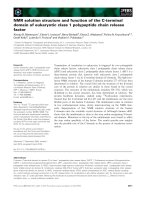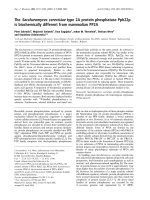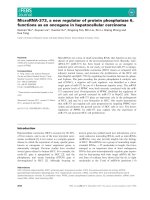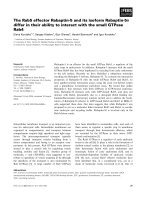The small GTPASE ARF like protein 1 (ARL1) is a new regulator of golgi structure and function
Bạn đang xem bản rút gọn của tài liệu. Xem và tải ngay bản đầy đủ của tài liệu tại đây (9.56 MB, 184 trang )
THE SMALL GTPASE – ARF LIKE PROTEIN 1 (ARL1)
IS A NEW REGULATOR OF GOLGI
STRUCTURE AND FUNCTION
LU LEI
INSTITUTE OF MOLECULAR AND CELL BIOLOGY
NATIONAL UNIVERSITY OF SINGAPORE
2003
THE SMALL GTPASE – ARF LIKE PROTEIN 1 (ARL1)
IS A NEW REGULATOR OF GOLGI
STRUCTURE AND FUNCTION
LU LEI
(B.SC.)
UNIVERSITY OF SCIENCE AND TECHNOLOGY OF CHINA
A THESIS SUBMITTED FOR THE DEGREE OF
DOCTOR OF PHILOSOPHY
INSTITUTE OF MOLECULAR AND CELL BIOLOGY
NATIONAL UNIVERSITY OF SINGAPORE
2003
i
Acknowledgements
This PhD thesis is impossible without the following people; my deepest and most sincere
gratitude goes to them:
My supervisor: Hong Wanjin, for his creative scientific ideas and inspirational guidance
through out my research project and for his kindness and caring about me.
My committee members: Manser Edward and Hunziker Walter, for their stimulating
discussion and critiques during my student annual committee meetings.
My past and present lab mates, it is them who created collaborating and stimulating
research environment in HWJ lab: Tang Bor Luen, Chan Siew Wee, Wong Siew Heng,
Xu Yue and Thuan Bui, for teaching me basic molecular, cell biological and
biochemical techniques without reservations; Singh Paramjeet and Tang Bor Luen for
critical and careful reading of my research papers from which this thesis was derived;
Horstmann Heinz and Ng Cheepeng for collaboration in electron microscopy (EM) in
Fig 13 and Fig 23; Wang Tuanlao for the collaboration on VSV-G in vitro ER-to-Golgi
transport assay in Fig 24; Tham Jill, Loh Eva, Tai Guihua, Ong Yanshan, Tran Thi
Ton Hoai, Lim Koh Pang and Huang Bin for sharing critical reagents for this study;
and other members of HWJ group for discussions and helps.
My special thanks also go to my collaborators: Gleeson Paul (University of Melborne)
for providing rabbit anti-Golgin-245 polyclonal antibody; and Marvin Fritzler
(University of Calgary) and Edward Chan (Scripps Institute) for supplying me the full
length cDNA of Golgin-97.
ii
I would like to express my gratitude to Yu Xianwen for her help in my yeast two-hybrid
assays. My appreciation also goes to the DNA sequencing and protein mass-spectrum
unit of IMCB for their excellent services. And for all those people in IMCB, who have
contributed their support, either directly or indirectly, to my research life in IMCB, please
accept my deepest thanks.
It is a great opportunity to express my gratitude towards my parents and sisters living far
away in China, for their encouragement, understanding and most important, their love.
They are in my heart.
Lu Lei
2003
iii
Table of Contents
Summary
List of Tables
List of Figures
Abbreviations
Chapter 1 Introduction of Arl1 and ARF family GTPases
1.1 Ras superfamily GTPases
1.2 ARF family GTPases and their classification
1.3 Review of ARF1 and Arl1 GTPases
1.3.1 ARF1
1.3.2 Arl1
1.3.3 Arl2
1.3.4 Arl3
1.3.5 Arl4
1.3.6 Arl4L
1.3.7 Arl5
1.3.8 Arl6
1.3.9 Arl7
1.3.10 Arl8
1.3.11 ARFRP1
1.3.12 ARD1
1.4 Rationale of this Study
iv
Chapter 2 Materials and Methods
2.1 Cloning
2.1.1 DNA manipulations
2.1.2 Constructs
2.2 Yeast two-hybrid
2.2.1 Gal4 based yeast two-hybrid screening
2.2.2 Yeast two-hybrid assays
2.2.3 β-galactosidase assays
2.3 Recombinant fusion proteins
2.3.1 Production of His-tagged Arl1 fusion protein in bacteria
2.3.2 Production of GST fusion proteins
2.4 Antibodies
2.4.1 Raising rabbit polyclonal antibody against rat Arl1 and human Golgin-97
2.4.2 Antibodies used in this study
2.5 Active Arl1 and ARF1 pull down assays
2.6 In vitro guanine nucleotide exchange reactions of GST fusion proteins
of Arl1, ARF1 and Arl4
2.7
35
S labeling of proteins by in vitro transcription and translation
2.8 GST fusion proteins pull down in vitro translated POR1 or GGA1
2.9 GST fusion proteins pull down assays using HeLa cytosol
2.10 Immunoprecipitation
2.11 Cell culture and transfection
2.12 Indirect immunofluorescence microscopy and confocal microscopy
2.12.1 Paraformaldehyde fixation
v
2.12.2 Methanol fixation
2.12.3 Indirect immunofluorescence labeling
2.13 VSV-G morphological transport assay
2.14 VSV-G biochemical transport assay
2.15 siRNA knock down of Arl1 and Golgin-97
2.16 SDS-PAGE
2.17 Coomassie blue staining
2.18 Western blot
2.19 Electron microscopy (EM)
2.20 Preparation of RIPA cell lysate
Chapter 3 Characterization of Arl1 antibodies and quantification of endogenous
Arl1 level
3.1 Generation of rabbit anti rat Arl1 polyclonal antibody
3.2 Characterization of different versions of Arl1 polyclonal antibodies
3.3 Quantification of endogenous Arl1 and ARF1/3 levels in cultured
mammalian cells
3.4 Quantification of active Arl1 content in cultured mammalian cells
3.5 Arl1 is inactivated by BFA treatment
3.6 Discussion
Chapter 4 Arl1 is essential for the structure and function of Golgi apparatus
4.1 Localization of endogenous Arl1 to the trans-Golgi/TGN in CHO cells
4.2 Saturable Golgi association of Arl1
4.3 N-terminal myristoylation of Arl1 is essential for its Golgi association
4.4 Construction of guanine nucleotide binding mutants of Arl1
vi
4.5 Expression of the GDP restricted form of Arl1 (Arl1T31N) causes
disassembly of the Golgi apparatus
4.6 Expression of GTP restricted form of Arl1 (Arl1Q71L) causes an
expansion of the Golgi membrane
4.7 GTP restricted form of Arl1 causes stable association of COPI, AP-1
and Golgi ARFs with the expanded Golgi membrane
4.8 Protein trafficking through the Golgi apparatus is inhibited by
Arl1(Q71L)
4.9 The cisternae of Golgi apparatus disorganized into an extensive
vesicular-tubular network upon over expression of Arl1(Q71L)
4.10 Arl1 is essential for in vitro VSV-G ER to medial Golgi trafficking
4.11 Discussion
Chapter 5 Arl1 and ARF1 have shared and unique effectors
5.1 Gal4 based yeast two-hybrid screening of a human brain cDNA
library using the GTP restricted form of Arl1 as bait
5.2 Initial characterization of the interaction of Arl1 with its putative
effectors
5.3 Discussion
Chapter 6 Active Arl1 interacts with the autoantigens Golgin-97 and Golgin-245,
and recruits them on to the Golgi membrane
6.1 Arl1 interacts with Golgin-97 through its GRIP domain
6.2 Arl1 interacts with Golgin-97 and Golgin-245 in pull down and
immunoprecipitation experiments
6.3 Comparison of GRIP domain sequences
6.4 Conserved amino acids in GRIP domain are essential for their
interaction with Arl1-GTP
6.5 The switch II (SWII) region of Arl1 interacts with the GRIP domain
vii
6.6 Generation of Golgin-97 polyclonal antibody
6.7 Golgin-97 is localized to the trans side of the Golgi apparatus or TGN
6.8 The concerted Golgi dissociation kinetics of Arl1, Golgin-97 and
Golgin-245 upon BFA treatment
6.9 Arl1-GTP recruits Golgin-97 and Golgin-245 to the Golgi apparatus,
while Arl1-GDP dissociates them from the Golgi
6.11 Golgin-97 and Golgin-245 translocate to endosomes upon artificially
tethering active Arl1 to the endosome
6.12 Knocking down of Arl1 dissociated Golgin-97 and Golgin-245 from
Golgi apparatus but not vice versa
6.13 Discussion
Chapter 7 Conclusion and future perspectives
References
viii
Summary
Arls (ARF like proteins) are a group of small GTPases that are homologous to ARFs
(40~60% in sequence identity), but they do not have the following three activities as all
ARFs do. 1) They do not serve as ADP ribosyltransferase cofactors. 2) They do not
rescue lethal phenotype of arf1/arf2 double deletion yeast. 3) And they do not activate
phospholipase D (PLD). As the first member of the Arl group to be described, Arl1’s
cellular and molecular functions, except for its Golgi localization in mammalian cells, are
still unknown. The lack of studies of Arl1 is in stark contrast to the extensive work
conducted on ARFs. This thesis describes the characterization of Arl1 and its effectors,
especially GRIP domain Golgins and provides molecular and cell biological evidences
that Arl1 regulates the structure and function of the Golgi apparatus. Using an Arl1
specific polyclonal antibody, the cellular level of Arl1 in several cell lines was estimated
to be 10
-3
-10
-4
of total cellular proteins, which is in a similar range as ARF1/3. The
active GTP-bound form of Arl1 was determined to be ~20% of total Arl1 by a novel pull
down assay developed in this study. Electron microscopy (EM) revealed that
endogenous Arl1 was localized to the trans-side of the Golgi in CHO cells. The Golgi
association of Arl1 was found to be saturable and dependent on its N-terminal myristoyl
lipid group. The effects of exogenous expression of guanine nucleotide binding mutants
of Arl1 was characterized in vivo: Arl1T31N, the GDP restricted form, was observed to
disassemble the Golgi apparatus, while Arl1Q71L, the GTP restricted form, was found to
expand the Golgi membrane and to recruit COPI and AP-1 coats to the Golgi such that
the association of these coats became no longer Brefeldin A (BFA) sensitive. In the
ix
Arl1Q71L expressing cells, it was found that the Golgi was transformed to extensively
vesicular and tubular profiles as observed under EM. The normal secretory function of
the Golgi was disrupted and the trafficking of VSV-G was trapped in the vesicularized
Golgi. Using a yeast two-hybrid screen, putative effectors of Arl1 were identified. These
included, POR1, MKLP1, pericentrin, Golgin-97, Golgin-245, GCC1 and KIAA0336.
While POR1 and MKLP1 interacted with both Arl1 and ARF1; the others, including
Golgin-97, Golgin-245, GCC1, KIAA0336 and pericentrin, were found to interact
exclusively with Arl1, implying that both Arl1 and ARF1 have shared and unique
effectors. The existence of shared effectors suggests a possible communication between
Arl1 and ARF1. Later studies focused on the GRIP domain containing Golgins,
including Golgin-97, Golgin-245, GCC1 and KIAA0336. Arl1-GTP interacted with the
GRIP domains of Golgin-97 and Golgin-245, a process which was dependent on
conserved residues of the GRIP domains, which are also important for Golgi targeting.
The switch II region of Arl1 was found to confer the specificity of this interaction. Arl1-
GTP (Arl1Q71L) recruited Golgin-97 to the Golgi membrane in a switch II-dependent
manner. Artificially tethering of Arl1-GTP onto endosomes resulted in the endosomal
targeting of Golgin-97 and Golgin-245. Furthermore, Golgin-97 and Golgin-245 were
found to dissociate from the Golgi when Arl1 was knocked-down by its siRNA. Thus,
one of the functions of Arl1-GTP is to recruit Golgin-97 and Golgin-245 onto the Golgi
membrane via interaction with their GRIP domains. Collectively, the research presented
in this thesis reveals Arl1 as a new regulator of Golgi structure and function, and one
mechanism of Arl1’s functions is that it recruits its effectors — GRIP domain containing
Golgins on to the Golgi membrane.
x
List of Tables
Table 1 Small GTPases have conserved primary sequences in their guanine nucleotide
binding boxes G1-G5.
Table 2 A comparison of the identities and divergences of ARF and Arl subfamily small
GTPases.
Table 3 List of DNA plasmid constructs made for this study.
Table 4 Positive clones from yeast two-hybrid screening of pretransformed human brain
cDNA yeast library using Arl1-Q71L as the bait.
Table 5 Arl1 and ARF1 have unique and shared effectors.
Table 6 The yeast two-hybrid interaction assays of Arl1 and ARF1 with their putative
effectors.
xi
List of Figures
Fig 1 Classification of mammalian ARF family small GTPases.
Fig 2 A schematic diagram of Ras structure showing the typical G protein fold: six-
stranded β-sheet surrounded by α-helices and connected by polypeptide loops.
Fig 3 The conserved guanine nucleotide binding boxes in the structure of Ras complexed
with a nonhydrolyzable GTP analog, GppCp.
Fig 4 The conversion of active and inactive small GTPase is regulated by its GTPase
activating protein (GAP) and guanine nucleotide exchange protein or factor (GEP or
GEF).
Fig 5 Sequence alignment of ARF and Arl subfamily small GTPases.
Fig 6 Phylogenetic tree of ARF family small GTPases assembled by clustal W method
using the DNA Star software.
Fig 7 A prevailing model for the function of ARF1 in coat protein recruitment.
Fig 8 Characterization of polyclonal antibody against full length Arl1.
Fig 9 Full length, E6P1 and E6P3 Arl1 antibodies react differently towards human and
rat Arl1.
Fig 10 Quantification of endogenous Arl1 and ARF1/3 levels in various cell lines.
Fig 11 Quantification of active Arl1 in 293T cells using the GRIP-domain pull down
assay.
Fig 12 Cellular Arl1 is inactivated by BFA treatment.
Fig 13 Enrichment of Arl1 on vesicular-tubular structures on the trans-side of the Golgi.
Fig 14 Saturable association of Arl1 with the Golgi apparatus.
Fig 15 The Golgi association of Arl1 depends on its N-terminal myristoylation.
Fig 16 The construction of Arl1 guanine nucleotide binding mutants.
Fig 17 The GDP restricted form of Arl1 (Arl1T31N) disassembles the Golgi apparatus.
xii
Fig 18 Expression of the GTP restricted form of Arl1 (Arl1Q71L) causes an expansion of
the Golgi membrane.
Fig 19 Arl1(Q71L) causes massive BFA-resistant Golgi recruitment of COPI coat (β-
COP).
Fig 20 Arl1(Q71L) causes massive BFA-resistant Golgi recruitment of AP-1 coat (γ-
adaptin).
Fig 21 Arl1(Q71L) causes massive BFA-resistant recruitment of Golgi ARFs to the Golgi
membrane.
Fig 22 Transport of VSV-G to the cell surface is inhibited at the Golgi stage in
Arl1(Q71L) expressing cells.
Fig 23 Over expression of Arl1(Q71L) transforms the Golgi into an extensive vesicular-
tubular network.
Fig 24 Arl1 polyclonal antibody inhibited the trafficking of VSV-G from ER to the Golgi
in vitro.
Fig 25 In vitro binding assay showed that POR1 interacts with both Arl1 and ARF1 in a
guanine nucleotide dependent manner.
Fig 26 GTP-restricted Arl1 interacts with the GRIP domains of Golgins.
Fig 27 Arl1 interacts with the GRIP domain Golgins in pull down and
immunoprecipitation experiments.
Fig 28 Alignment of the amino acid sequences of four GRIP domains of human (prefix h)
and Drosophila (prefix d) Golgins defines several conserved residues.
Fig 29 Conserved residues of the GRIP domain are important for interaction with Arl1 as
well as for Golgi targeting.
Fig 30 Alignment of the N-terminal 93 residues of rat Arl1 with the corresponding
regions of Arl1 and ARF1 of other species.
Fig 31 The switch II region of Arl1 is necessary for its interaction with GRIP domains.
Fig 32 Generation and characterization of Golgin-97 polyclonal antibody.
Fig 33 Endogenous Golgin-97 is localized to the trans side of the Golgi or TGN.
Fig 34 Golgi dissociations of Golgin-97 and Arl1 are temporally coupled in response to
BFA treatment.
xiii
Fig 35 GTP-restricted Arl1 recruits Golgin-97 onto the Golgi apparatus in a switch II
region-dependent manner.
Fig 36 GDP-restricted Arl1T31N abolishes Golgi association of Golgin-97 and Golgin-
245 but not GM130 and p115.
Fig 37 Ectopic targeting of Arl1Q71L but not ARF1Q71L onto endosomes results in
selective recruitment of Golgin-97 onto the endosomal membrane.
Fig 38 Knockdown of Arl1 levels by siRNA dissociates Golgin-97 and Golgin-245 from
the Golgi apparatus.
xiv
Abbreviations:
ACAP ARF GAP with coiled-coil, ankyrin repeat and PH domains
Ade adenine
AP-1/2/3/4 adaptor protein-1/2/3/4
ARAP ARF GAP with GTP-binding protein like, ankyrin repeat and PH
domain
ARD1 ARF domain protein 1
Arl1 ARF like protein 1
ARF1 ADP ribosylation factor 1
ARFRP1 ARF related protein 1
ARNO ARF nucleotide binding site opener
BFA Brefeldin A
Big1/2 BFA inhibited GEF1/2
Big-2 brain-derived immunoglobulin protein-2
BLAST Basic Local Alignment Search Tool
BSA bovine serum albumin
CHO Chinese Hamster ovary
CIAP calf intestinal alkaline phosphatase
COPI/II coat protein complex I/II
CPY carboxypeptidase Y
DME Dulbecco’s modified Eagles (medium)
DMP dimethyl pimelidate
DMPC L-α-dimyristoylphosphatidylcholine
xv
DTT dithiothreitol
EDTA ethylenediaminetetraacetic acid
EGFP enhanced green fluorescent protein
EM electron microscopy
ER endoplasmic reticulum
FITC fluorescein isothiocyanate
Gal4-BD Gal4 DNA binding domain
Gal4-AD Gal4 DNA activating domain
GARP Golgi-associated retrograde protein
GAP GTPase activating protein
GDI guanine nucleotide dissociation inhibitor
GDP guanosine diphosphate
GEF guanine nucleotide exchange factor
GFP green fluorescent protein
GGA1/2/3 Golgi-associated, γ-adaptin ear homology, ARF binding protein
1/2/3
GM Golgi matrix (as in GM130)
GPI glycosylphosphatidylinositol
GRIP G
olgin-97, RanBP2α, Imh1p and p230/Golgin-245
GST Glutathione-S-transferase
GT β-1,4 galactosyltransferase
GTP guanosine triphosphate
GTPase GTP hydrolase
HEPES N-2-hydroethylpiperizine-N’-2-ethanesulfonic acid
xvi
HRG4 human retinal gene 4
HRP horseradish peroxidase
IC intermediate compartment
IF immunofluorescence
Imh1p integrin and myosin homology 1
IP immunoprecipitation
IPTG isopropyl β-D-thiogalactopyranoside
KAc potassium acetate
kD kilo Dalton
M molar
Mab monoclonal antibody
MAP microtubule associated protein
MCBPE molybdenum cofactor biosynthesis protein E
MCS multiple cloning site
MKLP1 mitotic kinesin-like protein 1
ml milliliter
mM millimolar
mg milligram
NLS nuclear localization signal
nm nanometer
NRL normal rat liver
NRK normal rat kidney
ONPG o-nitrophenyl β-D-galactopyranoside
xvii
OD optical density
PA phosphatidic acid
PAGE poly-acrylamide gel electrophoresis
PCNT pericentrin
PCR polymerase chain reaction
PDEδ phosphodiesterase δ
Pfu Pyrococcus furiosus
PICK1 protein interacting with C-kinase 1
PLD phospholipase D
PM plasma membrane
PMSF phenyl-methyl-sulfonyl fluoride
PI4,5P
2
phosphatidylinositol 4,5-bisphosphate
POR1 partner of Rac1
PVC pre-vacuolar compartment
PX phox (homology domain)
QDO quadruple drop out
RIPA radioimmunoprecipitation
RPMI Roswell Park Memorial Institute (medium)
RNAi RNA interference
RP2 retinitis pigemntosa protein 2
SDS sodium dodecyl sulfate
siRNA small interfering RNA
SNARE SNAP receptor
xviii
SNX3 sorting nexin 3
SR SRP receptor
SRP signal recognition particle
SWII Switch II
TGN trans-Golgi network
Tris Tris(hydroxymethyl)aminomethane
VFT vps fifties
Vps vacuolar protein sorting
VSV-G vesicular stomatitis virus G protein
XDP xanthine diphosphate
XTP xanthine triphosphate
µl microliter
µM micromolar
1
Chapter 1
Introduction of Arl1 and ARF family GTPases
In eukaryotic cells, the dynamic and complex movement of proteins among different
organelles in the endocytic and secretory pathways is mediated by vesicular transport
and coordinated by various components of transport machineries belonging to
different families: SNAREs, Sec1/Munc18 family proteins, tethering molecules, Ras-
like Rab and ARF small GTPases (reviewed by Hong, 1996). The importance of
small GTPases, especially those of the ARF and Rab families, in protein trafficking is
underscored by the fact that each trafficking step examined so far involves an ARF or
Rab (reviewed by Hong, 1996). As they function as regulatory switches, ARF and
Rab family small GTPases have become one of the research foci in the protein
trafficking field. Existing data suggest that Rabs are involved in vesicle budding,
targeting, docking and fusion with acceptor membranes (reviewed by Collins and
Brennwald, 2000), while ARF GTPases regulate actin cytoskeleton and coat proteins
recruitment for vesicle budding (reviewed by Roth, 2000).
1.1 Ras superfamily GTPases
Guanine nucleotide binding proteins (also called GTPases or G proteins) exist in both
prokaryotic and eukaryotic cells. The GTPase has two states in vivo: the active or
GTP bound state and the inactive or GDP bound state. Widely used as molecular
switches in cells to control biological reactions, GTPases are involved in a myriad of
cellular processes. In the translation of mRNA to protein in bacteria, yeast or
mammalian cells, elongation factor EF-Tu and EF-G, both GTPases, ensure the
2
correct incorporation of aminoacyl tRNA into the ribosome. The p54 subunit of
signal recognition particle (SRP), also a GTPase, mediates the cotranslational
targeting of secreted and membrane proteins to the endoplasmic reticulum (ER) in
mammalian cells and to the plasma membrane in bacteria by recognizing the SRP
receptor (SR) on the target membrane, a subunit of which is also a GTPase (reviewed
by Hong, 1996). Diverse GTPases have evolved in eukaryotic organisms to facilitate
the control of signaling events on their endo-membrane systems. By their oligomeric
states, GTPases could be classified into heterotrimeric and monomeric GTPases.
Monomeric GTPases could be further classified as large GTPases, such as dynamin,
and small GTPases, such as ARFs. Small GTPases are monomeric guanine
nucleotide binding proteins with molecular weights in the range of 20-40 kD. More
than 100 small GTPases have been identified in eukaryotes (Takai et al., 2001). They
comprise a superfamily of proteins — the Ras superfamily of small GTPases.
According to their primary sequences and biochemical properties, members of the Ras
superfamily are classified into 5 families: Ras, Rho, Rab, ARF and Ran (Fig 1).
Fig 1 Classification of mammalian ARF famlily small GTPases.
Ras superfamily small G protein
Ras Rho Rab ARF Ran
ARF Arl Sar
ClassI:ARF1, ARF2, ARF3
ClassII: ARF4, ARF5
ClassIII: ARF6
Arl1, Arl2, Arl3, Arl4, Arl5, Arl6,
Arl7, ARFRP1, ARD1
Sar1a, Sar1b
3
Fig 2 A schematic diagram of Ras structure showing the typical G protein fold: six-stranded
β
-
sheet surrounded by α-helices and connected by polypeptide loops. Top, structure of Ras,
which is complexed with a GTP nonhydrolyzable analog GppCp (depicted in ball-and-stick
model) and is in its active state; Bottom, structure of GDP complexed inactive Ras. The switch
I and II regions, which change conformation the most between active and inactive Ras, are
darkened. Secondary structure elements and G-box regions are labeled in the top panel. The
single solid sphere represents Mg
2+
. (Adapted from Sprang, 1997.)
4
All small GTPases share consensus primary sequences in some regions, which are
responsible for guanine nucleotide binding. These residues form the core of the
GTPase fold, which, in the high resolution crystallographic structure of Ras, was
revealed to be a 200-residue domain consisting of a central six-stranded β-sheet
surrounded by α-helices (Sprang, 1997) (Fig 2). Those highly conserved amino acids
are located in five polypeptide loops that form the guanine nucleotide binding sites.
The five loops are designated the G-1 through G-5 boxes (Table 1 and Fig 3). The G-
1 box with the consensus sequences, GXXXXGK(S/T), contacts the α- and β-
phosphates of the guanine nucleotide. The G-2 box contains a conserved Thr residue
involved in the coordination of Mg
2+
. The G-3 box, DXXGQ, is responsible for
binding of the γ-phosphate of GTP. The guanine nucleotide ring is partly recognized
by the G-4 box, NKXD. The G-5 box, (T/G)(C/S)A, enforces the interaction of
GTPase with the guanine ring. Comparison of the structure of the GTP form (active)
to that of the GDP form (inactive) of small GTPases reveals two regions, switch I and
switch II, which change conformation drastically upon the hydrolysis GTP to GDP.
Most effectors of small GTPases utilize these two switch regions for interaction. For
example, GGA1, an effector of ARF1, utilizes both switch I and II regions of ARF1
for GTP-dependent binding (Shiba et al., 2003).
Table 1 Small GTPases have conserved primary sequences in their guanine
nucleotide binding boxes G1-G5. Sequences are from human correspondent proteins.
Conserved residues are highlighted. (Modified from Sprang, 1997).
Small GTPase
G1 G2 G3 G4 G5
Ras-K GAGGVGKS PTI DTAGQ NKCD
TSA
RhoA GDGACGKT PTV DTAGQ NKCD
TSA
Rab1a GDSGVGKS STI DTAGQ NKKD
CSA
ARF1 GLGAAGKT PTI DVGGQ NKQD TCA
Ran GDGGTGKS ATL DTAGQ NKVD
TSA
5
The well researched structure and function relationship of small GTPases makes it
possible to design a mutant GTPase, which has altered guanine nucleotide binding
affinity, specificity or hydrolytic activity. Some naturally occurred mutations in
oncogenic Ras GTPases also change their guanine nucleotide binding properties. In
the case of RasQ61L, Gln to Leu mutation abolishes the GTPase activity of Ras,
leaving it in a constitutively GTP bound active form and thus resulting in
transformation (reviewed by Wittinghofer et al., 1995). In general, substitution of Ala
for Ser (Thr) in the G-1 box, GXXXXGK(S/T), increases the affinity of the GTPase
Fig 3 The conserved guanine nucleotide binding boxes in the structure of Ras complexed with
a nonhydrolyzable GTP analog, GppCp. Polypeptide loops responsible for the binding of
gunanine nucleotide are represented in ball-and-stick model. Side chains of the highly
conserved G-box residues are darkened and labeled with the one-letter amino acid code.
(Adapted from Sprang, 1997.)









